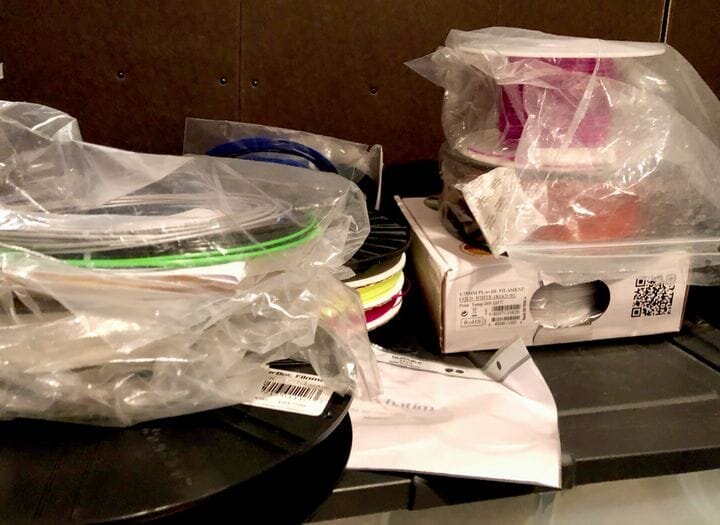![A pile of random 3D printer filaments, mostly stored in sealed bags [Source: Fabbaloo]](https://fabbaloo.com/wp-content/uploads/2020/05/image-asset_img_5eb08cfe61d78.jpg)
This week’s question asks how to best store and transport PLA 3D printer material in cold winter conditions.
Fabbaloo reader Ande asks:
“What is the optimal temperatures to store PLA? Should I not be leaving it in my car when it’s -20C? I threw the box away it came in that probably had that info.”
This is a very good question, Ande, as many people throw away the original storage box that comes with the filament spool. Many vendors provide information about the product on the box, but not the spool. Even Prusament’s fancy packaging system that includes a QR code lookup for detailed information is on the box, not the spool.
In fact, most people likely store their partly-used spools in bags or sealed tubs and don’t keep the informative boxes.
3D Printer Filament Storage
For spool storage, there are two main challenges: temperature and humidity, each causing different issues. Let’s look at temperature first.
Pure PLA has a glass transition temperature of around 60C, which is a surprisingly low temperature. This low temperature is partly what makes PLA so popular to 3D print: it doesn’t require much heat to soften.
But that low softening temperature also is a problem, because if the PLA material is exposed to temperatures of 60C or above, it will begin to slump. And that’s very bad news for a filament, which has to maintain a very precise diameter in order to 3D print properly.
The 3D printer’s extruder assumes a constant filament diameter, so in order to deliver a given amount of material per time to the hot end, it calculates how much to turn the extruder motor. But if the filament varies in diameter, you could be actually depositing more or less than desired. That could result in gaps, poor layer adhesion or blobs. Not good.
Storing PLA Filament in Winter
The moral of the story here is to always keep the filament below 60C. That should not be much of an issue if your ambient temperature is -20C! However, if in a vehicle at that temperature, make sure you don’t place the spool in the direct heater air flow, as it might be too hot.
In the summer, however, the dashboard of a car parked in a sunny location can easily hit 60C or higher, possibly destroying your filament spool. Never leave a spool of PLA in a hot car!
The equation changes a bit if you have materials other than PLA. ABS, for example, has a much higher glass transition temperature of 105C, a temperature likely unattainable in a car even in the hottest regions. ABS and similarly high temperature materials should be ok.
3D Printer Filament and Humidity
The second issue is humidity. Many thermoplastics tend to absorb humidity from the air – or even from water if directly exposed. The water molecules sink into the filament material where they cause multiple issues.
Some hydroscopic materials tend to absorb moisture at a higher rate, with the worst by far being nylon. A spool of nylon left out for more than a day or two will be soaked with moisture and have extremely poor print quality if used. PLA is average in this regard.
As the water-soaked filament is pushed through the hot end, the water inside boils as it is raised to extrusion temperature along with the PLA material. This causes bubbles in the 3D print, and you can even see or hear them if you look closely at the nozzle during printing. If you hear small “pops”, your filament is corrupted.
Other effects might be fragile prints, poor surface quality, bubbles, gaps, blobs, etc. All are not desirable.
The solution to the humidity problem is to slowly bake your 3D print at 30C or so for several hours. This will gradually release moisture from the filament. There are also several types of “filament dryers” that can accomplish this is a less risky fashion than using your kitchen oven. Remember, if the temperature reaches 60C, your filament is cooked.
Sealed 3D Printer Filament
A second, preventative measure is necessary: store the filament spool in a sealed plastic bag with a desiccant packet or two. Or ten. This prevents moisture from the ambient air to infest the filament, if you diligently keep the filament in the bag and not leave it, say, on your 3D printer for a few weeks in the open air.
In the summer, filament may be exposed to hot, humid air, so the plastic bag treatment is a necessity. However, in winter things are a bit more complex. For such a low temperature of -20C, there isn’t much moisture in the atmosphere, so that should not itself be an issue.
However, there is an issue when you bring a super-cooled filament spool indoors, where the temperature suddenly moves from -20C to +20C. This will immediately generate condensation on the filament, making it wet, and that’s definitely not good.
If the winter filament was also stored in a sealed plastic bag with a packet of desiccant, or ten, it will not be covered with condensation and should survive.
Bottom line: Always bag filament spools with desiccant and don’t leave them in a hot environment.
I hope that answers the question!

